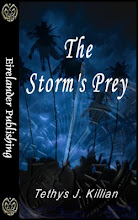No, I'm not talking of the book by Jennifer Weiner (that I read and adored, btw), nor of the movie that was adapted from said book.
I am literally talking of, walking in the shoes of your heroine.
T.J.'s post about shoes got me thinking, especially the part about thoughts in a story. Anyone who's ever read my work can and will probably tell you my stories can be compared to the psychoanalysis of the characters in the foil of their respective story and the plot. Meaning - I'm big on thoughts.
I reckon that not everyone has to agree with me. I know great writers who bind you in their plot yet cannot write a deep thought to save their life. I know of great writers who have next to nothing in way of plot but the thought process of the characters take you through a journey that has you panting and turning page after page for every 300+ sheet in the book. And yet the majority of writers, mostly the aspiring, beginning writers peopling the crit world, listen to only one rule - action forward and cut out unnecessary thoughts!
While I agree that the reader needs not be privy to each and every thought that goes on in a character's head (we know that could get terribly boring and tedious!), there is an inherent element to the thoughts-inclusion in a story - it's what binds you to the plot.
There's a difference between reading a book and watching a movie, even if both are dealing with the same story. Take this example:
At the start of the movie version of Bridget Jones' Diary, you hear the song All By Myself playing, and Bridget, played by a chubby Renee Zellweger, is alone in her flat, wrapped in a quilt, a bottle of whatever alcoholic beverage in her hand. Then she stands up, with the bottle still in hand, and she starts to move around the flat while singing along to the lyrics.
What does this tell you? Bridget is single, since she's at home on an evening (helped by the audio cue of the soundtrack through the song All By Myself) and she's drowning her sorrow in that bottle.
Now, we get this, allright. But what is Bridget's sorrow, other than she is by herself and drinking?
Go to the book, and read the first few chapters. First quote: 'Resolution number one: obviously, will lose twenty pounds. Number two: will find nice sensible boyfriend and not continue to form romantic attachments to alcoholics, workaholics, peeping-toms, megalomaniacs, emotional fuckwits or perverts.' I know I have used this example before in another post but I find it truly representative of what I'm trying to convey.
The Bridget of the movie, while still being the character penned by Helen Fielding, is a 'generic' version of the close-t0-30-London-singleton. Whereas the Bridget of the book is Bridget, the fully formed and realized Bridget Jones, not just a general idea of a woman in her shoes. And how is this possible? Through the thoughts of the character!
Something is lost in translation between the book and the screen, and the first thing to get the cut is thought processes. It's true that you cannot 'show' thoughts so easily in visual form, but still, taking out the thought processes takes you from a unique character to a generic character, that any writer could've penned given a few hints at psychology.
Take a further example, Confessions of a Shopaholic by Sophie Kinsella (being made into a movie releasing this year). Imagine Becky, the heroine, getting the urge at the shop to buy something when she knows she shouldn't. Her heart races, the need starts to pound in her head. Her throat goes dry and she simply needs, needs, needs, to buy whatever it is that has caught her fancy. When you read the book, you are privy to the battle and the struggle going on inside her, making you a part of Becky's world, making you urge her to not do this, to get out of there asap. But in the movie, maybe what you'll get is Becky at the store. You see her gaze land on something, you see her pause, maybe bite her lip, and then her hand reaches for her purse, and she pulls the credit card out. Inherently, you know what's happening, but here you do not know what's going on in her head.
We have to face it - many people read because they want this thought process. They want to be involved in the story, in the developments, in the character's journey. If your heroine has never worn Manolo Blahniks and she does buy a pair, your reader wants to know what it will be like for her to break those shoes in, what it feels like to wear them. Similarly, how does it make you feel to be in Jimmy Choo stilettos? And, when your former diva a la Gabrielle Solis trades her strappy sandals for comfy Mommy shoes, what's going on in her head at that moment?
In short, what does it feel like, what is it all about, to be in her shoes? Isn't this mainly what the heroine's (ultimately character's) journey is about? How do you get there without putting your reader in her head, in her thoughts, while you're in her shoes?
I'm eager to hear your thoughts on this! Any comments are more than welcome!
Aasiyah Qamar - Cultural Romantic Fiction, With a Twist
Coming out October 2 - Light My World - Eirelander Publishing
Nolwynn Ardennes - The Promise of Fulfilment
Coming out in January 8, 2010 - Storms in a Shot Glass - Eirelander Publishing
Aasiyah Qamar/Nolwynn Ardennes - Romance the world over
http://www.aasiyah-nolwynn.webs.com/
Thursday, June 18, 2009
In her shoes
Subscribe to:
Post Comments (Atom)





.jpg)
.jpg)






2 comments:
Z,
The lost of the thought process from a book to a movie is why most people who read the book are disappointed in the movie.
Very seldom can a movie do what a book does and vice versa. A movie can show actions better than a book. Although, I've seen some authors do very well with action.
Great post, Z. It makes you think.
Thanks Sandy! I wanted to make readers and writers think about the whole process behind being in a character's persona, and thoughts are an integral part of it.
Hugs
Z(Aasiyah/Nolwynn)
Post a Comment